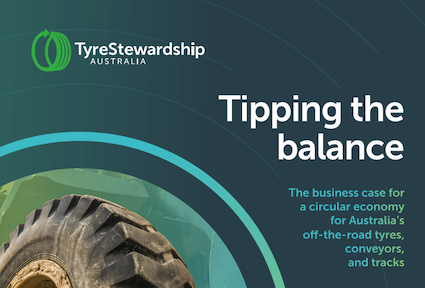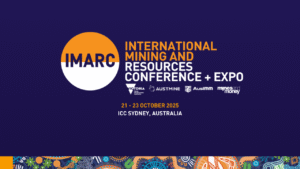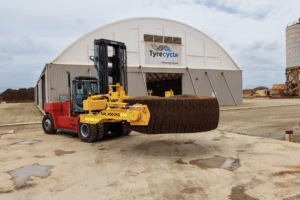Understanding the TyreStewardship Australia Tipping the Balance Report
Australia has built a reputation as a global leader in mining and agriculture, sectors that are vital to the nation’s economic prosperity. However, these industries’ success has come at an environmental cost, particularly concerning the disposal of off-the-road (OTR) rubber products such as tyres, tracks, and conveyor belts. In this article, we’ll explore the findings of the TyreStewardship Australia Tipping the Balance Report. “Tipping the Balance” report, which provides a comprehensive analysis of the challenges and opportunities surrounding the recovery and recycling of OTR rubber products in Australia.

TyreStewardship Australia Highlights the Staggering Scale of the Issue
According to the TyreStewardship Australia report, Australia generates an estimated 130,000 metric tonnes of used OTR tyres each year, with an additional 115,000 metric tonnes of rubber tracks and conveyors. Shockingly, only about 10% of these materials are currently recovered, with the rest being buried, stockpiled on-site, or sent to landfills. This practice not only wastes valuable resources but also poses significant environmental, social, and economic risks.
Recovery Rates by Sector
The TyreStewardship Australia report highlights the stark contrast in recovery rates across different sectors:
- Mining: Generates 79% of used OTR tyres, with a recovery rate of less than 2%.
- Agriculture and Forestry: Generates 11% of used OTR tyres, with a recovery rate of less than 1%.
- Construction and Demolition: Generates 6% of used OTR tyres, with a recovery rate of around 80%.
- Industrial (Manufacturing and Trade): Generates 4% of used OTR tyres, with a recovery rate of around 80%.
- Aviation: Generates less than 1% of used OTR tyres, with a recovery rate of around 80%.
Comparison with Global Recovery Rates
The report also compares Australia’s OTR tyre recovery rate with other jurisdictions, highlighting the stark contrast:
- Denmark: 100% OTR recovery.
- Ontario, Canada: 87% large OTR tyre recovery.
- France: 78% medium-large OTR tyre recovery.
- Australia: Less than 15% OTR recovery.

The Risks of Inaction from TyreStewardship Australia.
Failing to address the issue of OTR rubber product recovery carries significant risks for Australia, its industries, and communities.
- Market Risk: Australia risks losing out on the economic opportunities presented by a circular economy for OTR rubber products, as other countries invest in recovery and recycling facilities.
- Corporate and Compliance Risk: Mining companies risk facing increased costs if regulations change and on-site disposal is no longer permitted, potentially disrupting operations.
- Environmental Risk: Leaving OTR rubber products buried or stockpiled on-site can lead to long-term environmental impacts, such as erosion, water and soil contamination, and habitat loss.
- Social Risk: The current practices create social and economic impacts on indigenous peoples and local communities, undermining social licence and creating potential liabilities.
- Responsibility Risk: The current approach transfers the liability for these materials to future generations and landowners, contradicting the user-pays principle.
- Reputation Risk: Failing to address the issue of OTR rubber product recovery is at odds with community expectations and could damage the reputation of industries and governments.
- Strategic Risk: Australia’s reliance on international supply chains for OTR rubber products puts it in a vulnerable position, highlighting the need for self-reliance and resource recovery.
The Benefits of Change
TyreStewardship Australia shows how improving OTR rubber product recovery presents numerous economic, environmental, and social benefits for Australia.
Economic Benefits
- Growing and diversifying the Australian economy by capturing valuable resources contained in OTR tyres.
- Regional development through investment, employment, and labour force development.
- Innovation and productivity by addressing the OTR gap through new methods, technologies, and business models.
- Recovering the value of materials used, potentially translating into millions of dollars in recovered steel and crumb rubber.
- Job creation in the recycling industry, with the potential to create hundreds of direct and indirect jobs.
- Stimulating investment, as evidenced by private businesses investing $4.5 million for every $1 million provided by Tyre Stewardship Australia to support market development activities.

Environmental Benefits of OTR Tyre Recovery
- Recapturing high-quality materials that would otherwise be lost.
- Reducing reliance on new materials and the consequent environmental damage in rubber-growing countries.
- Improving the treatment of environments and landscapes.
- Reducing exposure to harms such as fire, habitat loss, contamination, and potential breeding grounds for vermin.
- Setting an example and lifting the accepted standard for managing end-of-life products.
- Reducing greenhouse gas emissions from new tyre creation and rubber deforestation.
Social Benefits of OTR Tyre Recovery
- Avoiding social impacts and costs, improving social license to operate.
- Translating economic benefits into improved livelihoods and positive social outcomes for indigenous peoples and local communities.
- Improving health and mortality outcomes by reducing exposure to environmental impacts.
- Enhancing repetitional outcomes for OTR tyre generators.
TyreStewardship Australia Roadmap to Recovery
The report outlines a roadmap to achieve a circular economy for Australia’s OTR rubber products, with key milestones and actions:
- Collaborate on Requirements and Potential Solutions: Extensive consultation with stakeholders is needed to establish shared goals, milestones, and tailored solutions for different regions and industries.
- Review Regulations and the Scheme: Examine waste and resource recovery policies and regulations at national, state, and territory levels to align recovery solutions and harmonise regulations across Australia.
- Build a Circular Economy: Encourage and develop a circular economy by exploring innovative business models, technologies, and commercial arrangements between manufacturers and customers, with a focus on a “tyres-into-tyres” model.
Key Takeaways
The TyreStewardship Australia “Tipping the Balance” report offers a comprehensive analysis of the challenges and opportunities surrounding the recovery and recycling of OTR rubber products in Australia. By addressing these issues, Australia can unlock significant economic, environmental, and social benefits while positioning itself as a global leader in the circular economy for these critical materials.
To learn more about the report and its findings, visit the Tyre Stewardship Australia website, where you can access the full report and additional resources.
References and Further Reading
- Tyre Stewardship Australia website (2023). Tipping the Balance: The Business Case for a Circular Economy for Australia’s Off-the-Road Tyres, Conveyors, and Tracks
- European Tyre and Rubber Manufacturers’ Association. (2022). Circular Economy: EU’s Plan
For Information about how TRG helps support businesses with OTR Tyre Management | Training | Labour Hire Contact us today for more information!






